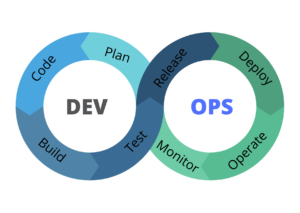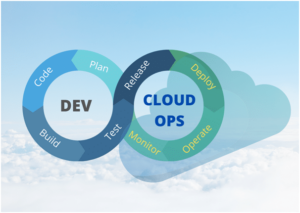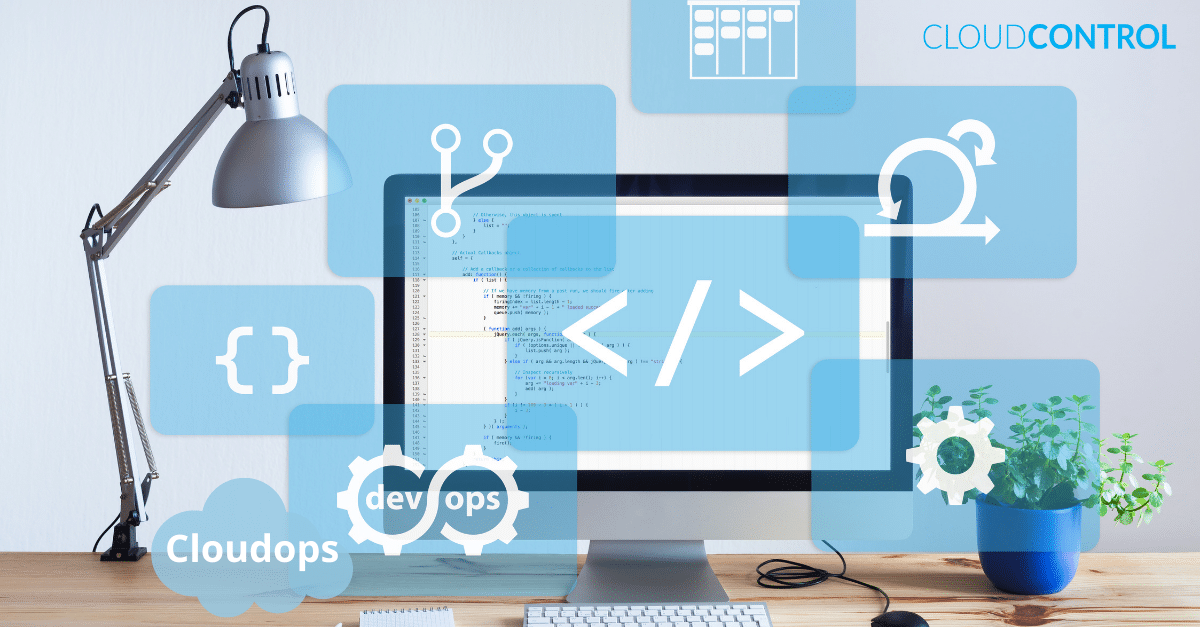DEVOPS Vs. CLOUDOPS
INTRODUCTION
DevOps adoption is increasing at a greater pace day by day. It continues to become a superior development choice for many enterprises as it helps businesses succeed in a competitive market. According to reports, “the DevOps market size is expected to increase and reach USD10.3 billion by the end of 2023”.
Worldwide spending on public cloud services is reported to grow 18.4% in 2021. The global pandemic in 2020 reinforced this trend and the relevance of the cloud. Deloitte’s annual report says: “global cloud spending will grow 7x faster than overall IT spend and revenue growth will remain greater than 30% for 2021 through 2025”. According to Forrester: “the global public cloud infrastructure market is predicted to grow 35% to USD 120 billion in 2021.”
These statistics show the rising adoption of DevOps and cloud technologies to automate business processes, become more agile, drive innovation and become cost-effective.
This article discusses two trending technologies DevOps and CloudOps along with their differences, merits, and demerits.
WHAT IS TRADITIONAL OPS?
Software teams worked in a segregated way before DevOps came in. Design and coding are done by developers; QA is performed by the testing team while deployments, and monitoring is executed by the operations team. Each team worked with a different mindset. Developers tend to make new applications and changes to existing applications based on business requirements. At the same time, the operations team wanted fewer changes as possible to maintain their environment stable, operate reliably and optimally. These conflicting agendas and cultural clashes were against the common good and organizational objectives. Traditional Ops lead to long queues, more time and effort for software releases, human errors in production, etc. That’s when the new philosophy called DevOps started.
WHAT IS DEVOPS?
DevOps is a short form for Development and Operations. DevOps is a set of software development practices that brings developers and operations teams together to cooperate towards common enterprise goals. It is a practice that allows the single team to manage the entire software development cycle. Each one in the team understands the objectives and works together for what is best for the organization. DevOps is a culture: it streamlines the way an organization works, removes conflicting agendas and frictions between teams, everyone takes responsibility to achieve common goals, which allows them to work more effectively, and together they drive the changes faster to the end customers. This change required the team members to know all the parts of the software development cycle as a whole and not some parts of it. This means, developers need to understand the infrastructure, and the operations team needs to understand the code. Organizations have to redefine the roles, processes, tools, and technologies to align teams with this new culture and achieve the best out it for the business.
DevOps helps to deliver reliable software more frequently. It consists of various stages like continuous development, continuous testing, continuous deployment, and continuous monitoring.

Fig: DevOps Life Cycle
Benefits of DevOps
- Agility: is one of the top objectives of DevOps. DevOps speeds up the product releases using continuous delivery. Frequent releases of new features and faster identification and fixing of bugs at early stages ensure the quality of product releases.
- Faster time to market and responsiveness to customer needs: DevOps helps the company to respond to new and change requests from customers faster, resulting in lesser time to market new features and changes.
- Better Work Environment: DevOps culture, principles, and practices reduces friction between teams, improves coordination, collaboration, communication, and bring out increased productivity.
- Automation: of DevOps processes like build, testing, configuration, deployment, and monitoring allows organizations to create a repeatable process that reduces manual time-consuming tasks and results in faster, consistent, frequent, and bug-free software deliveries.
- Continuous Development: DevOps practices help to achieve a continuous or iterative model of software development, meaning the software is developed as smaller portions for faster releases to production. This involves CI/CD (Continuous Integration and Continuous Delivery), continuous testing, continuous deployment, and continuous monitoring. DevOps tools and platforms are used to build such automated pipelines.
- Innovation & Productivity: DevOps practices and culture increases the productivity of team members and allows companies to innovate faster than their competitors.
- Fail Fast/Safe: DevOps promotes shorter software development cycles and frequent releases. This helps to fail early, detect defects early, and also to fix them early.
- Reduced costs: The benefits of DevOps translate directly into a reduction in general costs and human resources. Costs will be at least 30% lesser while DevOps practices are adopted.
- Security: By having fine-grained control, compliance, best practices, policies, and configuration management, DevOps helps to attain better security.
DevOps Best Practices
- Micro Services: Rather than having a single monolithic architecture, designing and deploying the application as a set of micro-services will provide more flexibility, scalability, and rapid deployments.
- Continuous Integration: Use a central code repository and integrate the code from all developers there. In this practice, developers merge their code with the master branch several times a day. Each merge may even trigger a build and deployment. Continuous Integration reduces bugs, risks from defects and makes developers more productive.
- Continuous Delivery: Build automated pipelines for continuous development, build, testing, deployment, and monitoring. This creates a standardized, repeatable process for software delivery.
- Monitoring: Continuously monitor, analyze and the infrastructure and performance of the application, get feedback, collect insights, identify issues and make improvements to the system continuously.
- Collaboration and Communication: Establish and maintain good communication between team members, assign responsibilities and promote a cultural shift to adopt DevOps practices and procedures for better productivity.
WHAT IS CLOUDOPS?
CloudOps is the short form for Cloud Operations, in which DevOps practices and procedures are applied to the Cloud Infrastructure. Previous to cloud computing, organizations used to maintain their own data centers for hosting servers and applications. CloudOps is all about continuous operations. CloudOps is a way of doing DevOps, where instead of using on-site data centers, it leverages the power of cloud computing. CloudOps augment the capabilities of DevOps. Cloud computing platforms provide multiple advantages compared to traditional IT infrastructure.

Benefits of CloudOps
Using CloudOps in conjunction with DevOps provides many advantages like speed, scalability, and productivity. Find below some of the benefits of using CloudOps.
- Scalability: Virtualization technology used by cloud infrastructure providers allows you to quickly and easily spin up new servers, additional storage, processing power, or other services on demand. The in-built monitoring tools help you monitor key performance metrics and fine-tune the system accordingly – enhancing flexibility and scalability.
- Less error, Less Latency: Cloud-based infrastructure is less prone to errors and latency issues due to the inherent flexibility and scalability.
- Redundancy: Data and applications can be clone in multiple servers or locations, providing redundancy and reliability. In a cloud environment, data and applications are stored in multiple storage devices and/or locations to provide more protection and to avoid single point of failures. This simplifies backup and DR management.
- Automation: Using IaC (Infrastructure as Code) technologies, one can implement more automated functions from creating the infrastructure, provisioning, deployment, monitoring, and applying changes based on set thresholds or key performance metrics, creating more robust self-healing systems.
- Availability: Active-Active networks and replication at application and database levels result in less downtime/outages in cloud environments.
- Optimized performance and capacity: Irrespective of the location or provider, or platform used, the cloud provides proper resource and performance management to speed up the business processes and changes.
- Cost-Effective: Setting up and managing own local data centers, network, and DR centers are very costly and critical to any organization. CloudOps provides on-demand resources and pay-as-you-go options, which reduces the cost and at the same time providing enough flexibility and scalability.
- Increased Security: CloudOps brings in best practices, security, and compliance as part of the cloud adoption. According to reports, 94% of the business saw improvement in security after migrating to the cloud.
CloudOps Best Practices
Many enterprises are in the process of adopting cloud computing. This requires a significant paradigm shift when one transit from on-site servers to a public cloud provider. CloudOps requires proper management of instances, services, configurations, and security to achieve optimum performance and costs. Below are some of the best practices to get the most out of your team and CloudOps.
- Cultural Shift: Train your employees and management on the changes in processes and procedures to shift their thinking to adopt the cloud. Make them understand how CloudOps can align with DevOps to achieve better agility, flexibility, and speed.
- Provisioning: There are generally two kinds of provisioning in CloudOps, namely self-provisioning and auto-provisioning. In self-provisioning, users can provision and use their own machines. But in auto-provisioning, the cloud provider will automatically provision and de-provision the machines based on requests by the application. Choose the right provisioning strategy to optimize resource utilization and costs.
- Setting Limits: Cloud is supposed to be an infinite resource pool. Set the right limits in your account and application level for computing power, storage, etc., and control the allocation of resources. Unlimited resource allocation and usages may lead to unexpected high cloud bills.
- Automation: Automation is the key. Automate as much as possible, starting from provisioning, configuration, governance, policies, etc. to create a repeatable process. Streamline the change management using automation so that it will not disrupt your development and delivery workflows.
- Security: Establish clear compliance and security policies, implement automated processes that test the configuration of cloud resources, automate security checks, automate remediation when risks are identified, and ensure consistency while the cloud footprint is growing.
- Self-healing: Automate the processes in such a way that, even when there are small issues or failures, it can correct the issue by itself and continue operation.
- Ensure Redundancy: One of the main objectives of CloudOps is continuous operations and zero downtime. Implementing automation and redundancy at the cloud provider level and application level ensures high availability for your services.
DEVOPS Vs CLOUDOPS
The following table describes the significant differences between DevOps and CloudOps.
| No: | Differences | DevOps | CloudOps |
|---|---|---|---|
| 1. | What is it? | It is a culture and software development practice covering SDLC | Leverages the power of cloud computing for continuous operations. CloudOps augment the capabilities of DevOps |
| 2. | Price | Costs are higher to set up and manage on-site infrastructure, network, etc. | Initial costs are lesser. Cloud uses a pay-as-you-use model. |
| 3. | Scalability | Scale-up may require the acquisition of additional hardware and other resources. Scale-up/down is not easy. | Resources can be scaled up or down easily based on the demand and business needs. It is more flexible. |
| 4. | Redundancy | A separate DR center needs to be set up to ensure redundancy and disaster recovery. | Cloud data can be replicated in multiple storage devices and locations. DR is already in place with cloud technology. |
| 5. | Availability | Local infrastructure needs to be managed by the organization to ensure high availability. | High availability is assured by the cloud provider |
| 6. | Performance | Performance is limited to the server and network capacity in the data center. | Computing power or storage can be increased/decreased based on demands. |
| 7. | Automation | Creates a standard and repeatable process using automation. | Allows higher levels of automation, starting from provisioning, configuration, governance, policies, etc. to create a repeatable process. |
| 8. | Accessibility | Accessibility is limited in on-site infrastructure and applications | Users can access resources from anywhere and work since it is in the public cloud. |
| 9. | Sharing | Sharing of data and services is limited | Sharing of resources across applications is easier in cloud environments. |
SUMMARY
DevOps and CloudOps are considered as two essential ingredients of digital transformation. It helps enterprises to get a competitive advantage to deliver software products and services more frequently in a cost effective manner, to provide a flexible, scalable, and secure cloud environment.
DevOps is a culture and a set of software development practices that brings developers and operations teams together to cooperate towards common enterprise goals, whereas CloudOps brings together various roles such as cloud architecture, software development, IT operations, security, and compliance processes to manage products and services in the cloud.
About The Author

Dr. Anil Kumar
VP Engineering, Cloud Control
Founder | Architect | Consultant | Mentor | Advisor | Faculty
Solution Architect and IT Consultant with more than 25 years of IT Experience. Served in various roles with both national and international institutions. Expertise in working with both legacy and advanced technology stacks and business domains.

